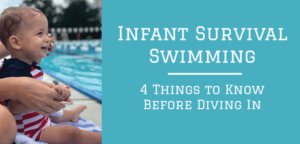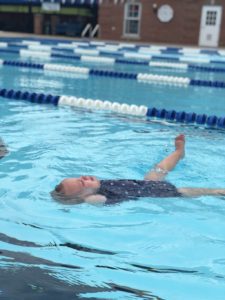
Accidental drowning is the number one cause of child fatalities in the US under the age of 4. The American Pediatric Association strongly recommends water safety instruction for children around 12 months but despite the wide variety of swim classes offered, few teach true survival skills to young children in the water. Infant Self Rescue (ISR) is one of few that does.

When my twin boys turned 3 months old, I eagerly signed up for the “mommy and me” water acclimation classes at a nearby pool. Nearly every week for a year, my mom and I splashed, sang catchy songs and blew bubbles with 6 other parent-child duos. The boys loved it. I did too. Bathtime became easier and it was a great excuse to get out of the house.
The boys were having fun and taking great naps after class, but I was starting to question as we ran through the motions each week…were my kids learning true water survival skills? Not really.
Then several months later, in June 2018, I was brought to tears listening to the news about 19-month-old Emmy Miller, Olympic skier Brody Miller’s daughter, who tragically drowned in a neighbor’s pool. I was nauseous. My twin boys were two months younger than Emmy and it couldn’t help but think, “it could have so easily happened to us.”
Deep down, I knew if one of my sons accidentally fell into the water, even after a year of weekly swim classes, they definitely wouldn’t have the skills to save themselves. I canceled the mommy and me classes and immediately signed my 13-month-old twin boys for infant survival swimming or ISR within the hour of learning of Emmy’s drowning. And it’s one of the best parenting decisions I’ve made to date.
How is ISR different than other swimming programs?
The first infant self-rescue swimming program began in 1966 and took a radically different approach for teaching water safety skills to children under the age of 6. Backed by more than 45 years of research in pediatrics, child development, behavior, and psychology, the ISR program teaches children, even 6-month-old infants, basic survival swimming skills like rotating to the back to float. While pool fences, adult supervision, and alarms are excellent measures for drowning prevention, it is ISR’s core belief that equipping the child with water survival skills is the single most important part of a drowning prevention strategy.
4 Things to Know Before Diving Into ISR
The primary focus is teaching kids how to get air (survive).
All children are taught the same foundational element, independent of age: floating on their back to conserve energy. In a safe, controlled and closely monitored environment, kids learn how to problem-solve in any depth of water. The instructor remains within inches of the child and doesn’t allow more than four seconds to pass without him/her getting air.
Lessons are only 10 minutes long, but they’re 5 days a week
While the lessons are shorter compared to other swim classes, classes are held every day for about 4-8 weeks. Research shows that short, more frequent lessons result in greater retention and mastery of skills. Kids have notoriously brief attention spans and the shorter one-on-one instruction allows the child to get the most out of each lesson.
ISR lessons begin in the middle of the pool
Many swimming programs start lessons on the pool wall and gradually if at all, work their way toward the middle of the water. By teaching the skills in the middle of the pool and gradually moving towards the wall, the child gains both confidence and masters the ability to float and/or swim without holding on to a parent, instructor, wall or flotation device.
ISR isn’t traumatic.
So let’s just nip these two common myths in the bud.
MYTH 1: ISR causes excessive crying and fear of the water
TRUTH: You know the difference between the “I’m tired” cry and the “I’m in excruciating pain” cry? The cries are distinctly different in octave, intensity and the production of actual tears. Likewise, kids often cry because they’re not ready to transition to the next activity or just want to make it known that they’re not loving the situation. An upset child and a traumatized child are very different. If a child is truly traumatized, the crying would continue long after the lesson has finished.
MYTH #2: In survival swimming classes, kids are thrown in the pool with their clothes on and expected to save themselves.
TRUTH: Children are never asked to do a skill in the water they haven’t already learned. After nearly 6 weeks of repetitions, instructors ask for the children to dress in summer clothes and shoes for the next class to mimic real-world scenarios. The child is NOT thrown in the water and expected to survive, rather a normal class is just performed with their clothes on. Their survival training from the previous weeks kicks in and they automatically know how to float without hesitation.
Infant Survival Swimming isn’t everyone’s cup of tea. That’s okay. But I just wish that as a society, we could be as diligent about teaching our children water survival skills as we are about slathering on sunscreen to prevent sunburns and skin cancer.
Why is it that our kids always manage to find the most dangerous things to get into in the three seconds we aren’t watching or have our backs turned? (Because in my house, they are repeat offenders!)
But if a body of water is nearby, seconds can be deadly. I’m just not willing to take that chance. Lives can change in an instant, but you can prepare proactively and set your child up for success in the water. ISR is an investment of time, money and trust. Trusting in the process, the instructor and most importantly, your child.
For more information on ISR or to find classes in your area, visit infantswim.com











